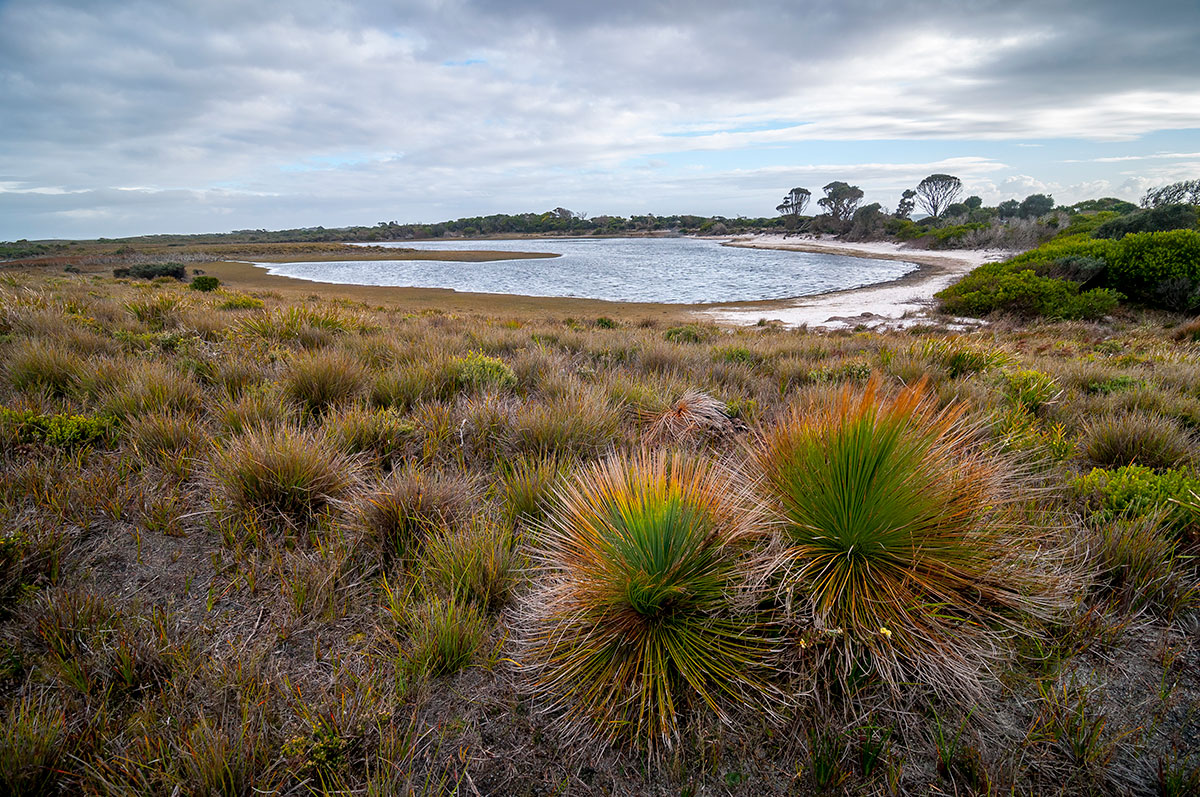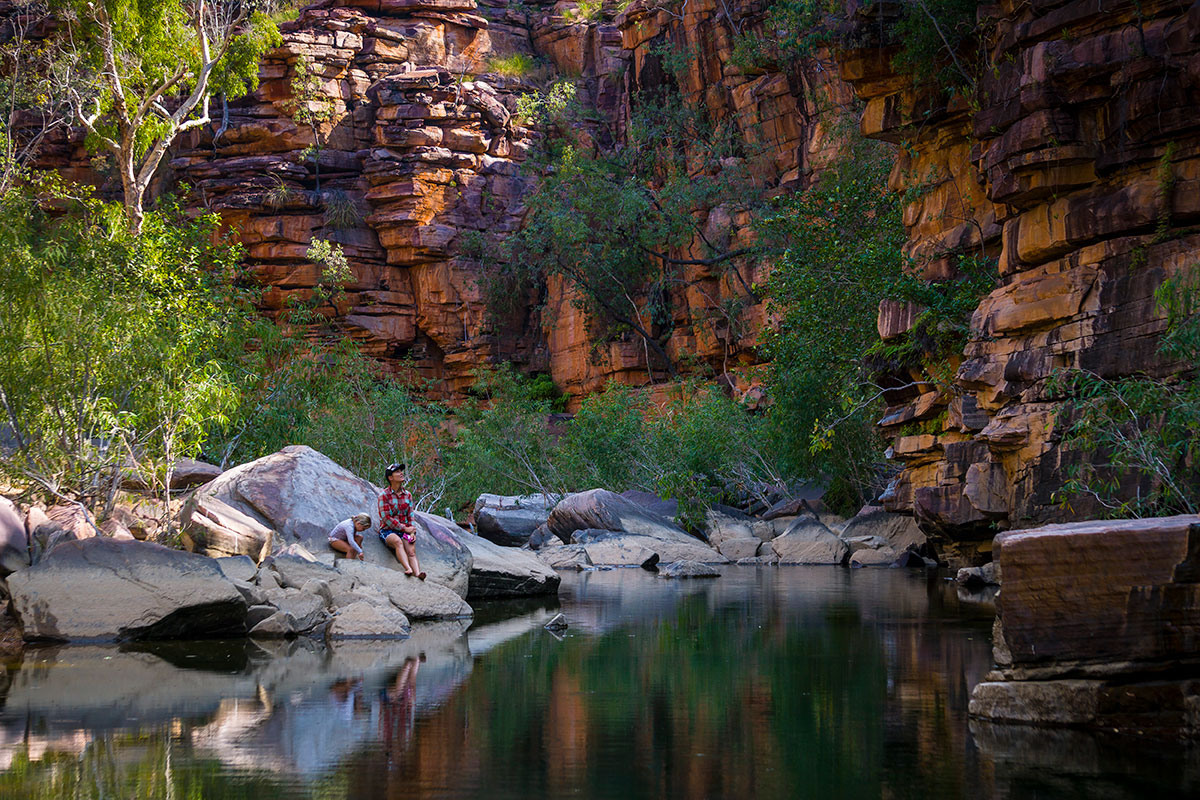These stellar nature reserves and touring routes are accessible to all, with unsealed, but smooth roads, each destination showcasing distinctly different natural environments. Think freshwater crocodiles, Indigenous rock art, salt pans and towering sandstone formations, and get ready for adventure!
If you’re travelling with a conventional rig and itching to escape the blacktop, these top five journeys will take you there.
1. GIWINING – FLORA RIVER NATURE RESERVE, NT

This tiny savannah reserve is a great find for all travellers, located just 46km off the Victoria Highway and offering superb camping, riverside walks, angling and unique wildlife encounters on the impossibly translucent Flora River.
Here, little red flying foxes cling restlessly to the treetops, squawking high above limestone tufa waterfalls that send the Flora River tumbling and swirling into dynamic, emerald spas. You can launch your canoe or travel-sized tinny to explore the river far downstream, and dangle a line to snare a tropical catch of barramundi, bream, catfish and grunters as the Flora’s freshwater crocodiles hover on the sidelines.
Djarrung and Kathleen Falls are easily accessible via short, riverside walking trails, and the spacious Djarrung Campground provides generously for campers with hot showers and roomy sites. After a solid day of fun down on the Flora River, return to camp and settle back as the stars appear, stoking a campfire and watching the northern nailtail wallabies that silently emerge to graze on the edge of camp.
During the dry winter months (June to October) when this far northern region comes alive, the nature reserve’s gravel access track is suitable for conventional vehicles and rigs.
Fast Facts
Where: Turn off the Victoria Highway 86km west of Katherine and continue for 46km to the park.
Facilities: Campsites cost $6.60/adult, $3.30/child (5-15 years) or $15.40/family. Hot showers, wheelchair-accessible toilets, drinking water, picnic tables, fire-pits, a boat ramp, canoe slide and walking trails are provided (no pets, bins, generators or firewood collection).
More Info: head to nt.gov.au/parks or visitkatherine.com.au.
Ratings: RV Infrastructure: 4, Attractions: 4, X-Factor: 5.
2. GRANITE & WOODLANDS DISCOVERY TRAIL, WA

Well-groomed and suitable for all kinds of rigs, this impossibly scenic route from Norseman to Hyden lures travellers to the edge of crumbling painted cliffs and up gently sloping granite outcrops for views over the endless bluebush plains.
Nights are spent free camping on the shores of bright pink salt lakes and nestled in breezy groves of rare ribbon gums. There are 16 signposted discoveries to be made along this 300km-long route, so be prepared to slow your pace and allow plenty of time to explore the historical sites, grand vistas, discover water-filled gnammas, and at journey’s end, the unmissable, 15m-high Wave Rock.
Don’t miss a stop at Disappointment Rock (which is anything but), and a night at Lake Johnson where a row of tall salmon gums mysteriously fringes the salt pan. Further west, hakeas and flame grevilleas colour the sandy heathlands all the way to the Breakaways and its colourful crumbling cliffs of brightly striped shales and sandstones.
In the far west, Hyden is home to Australia’s most famous rock wave and few can resist a play at this 2700-year-old prehistoric surf spot. After riding the curl, you can explore further and discover Hippos Yawn, Lake Magic and Mulka’s Cave, one of WA most significant Indigenous rock art sites.
Fast Facts
Where: The Granite and Woodlands Discovery Trail links Norseman to Hyden, 300km away in WA’s southwest. Except after heavy rain, the unsealed track is suitable for all vehicles, including those towing caravans. Plan your travels for the cool winter months.
Facilities: Basic free campgrounds at Lake Johnson, McDermid Rock, the Breakaways and Forrestania Plots provide picnic tables, toilets, fire pits and walking trails (no bins). Dogs and generators are permitted. Carry ample drinking water, firewood and supplies. There are caravan parks at Norseman and at Hyden’s Wave Rock.
More Info: Visit norseman.info, download a route brochure at dundas.wa.gov.au and plan your big adventure at australiasgoldenoutback.com.
Ratings: RV Infrastructure 2, Attractions 4, X-Factor 4.
3. BOODJAMULLA NATIONAL PARK, QLD

If kicking up dust and a few corrugations don’t scare you, this emerald spring-fed oasis is within your reach. Drive with care and conventional vehicles and rigs can easily conquer the partly sealed 100 kilometres from Gregory Downs to the waterfront camps in Boodjamulla National Park.
Named for the Boodjamulla or Rainbow Serpent that carved out Lawn Hill Gorge, this top destination in the state’s rugged northwest dazzles travellers who fill lazy days on the water, paddling and cruising to limestone tufa waterfalls and swimming with freshwater crocodiles and fat barramundi en route (no salties in sight). There are excellent short hiking trails, Waanyi rock art to discover and a good choice of campsites, a bargain at just $6.15 per person.
Upstream of the campground at Indarri Falls, delicate tufa dams segregate the creek into staggered, deep gorges, equally impressive at sunset from the bow of a canoe or atop a towering red rock lookout. With a snorkel and mask you can view the tufa wall up close through the chilly, translucent water and maybe spot barramundi, snapping turtles and archerfish too.
Bring your own canoe or hire one on site to tackle the 6km-long paddle to Indarri Falls and beyond into Upper Gorge, following a vivid maze of fan palms and water lilies (allow two hours). Don’t miss a walk to the top of the Constance Range for sunset (BYO torch for the return journey) and book your campsite well in advance for peak wintertime stays.
Fast Facts
Where: Drive 100km west of Gregory Downs via the Wills Developmental Road. Visit from May to September. The park gets busy during school holidays and may be cut off by wet season rains (December to March).
Facilities: Entry is free and national park campsites cost $6.15pp (free for kids under 5yrs) and provide coldwater showers, drinking water, swimming and canoe access and an interpretive centre
More Info: npsr.qld.gov.au/parks.
Ratings: RV Infrastructure 3, Attractions 5, X-Factor 5.
4. MOUNT WILLIAM’S WILD SANCTUARY, TAS

Harbouring Forester kangaroos, pademelons, echidnas and Tassie devils in a remote corner of the island, this coastal sanctuary of heathlands and plains offers top camping, walks and beach angling. Between Eddystone Point Lighthouse and Great Musselroe Bay in the north, travellers can settle into excellent campsites just a stone’s throw from the water, each providing top facilities for as little as $50 per week.
Caravanners will love the big sheltered campsites at Stumpy Bay Camp 3 with tables and firepits and a bore water tap, overlooking a magnificent sweep of ocean and frequented by pademelons. The national park’s beaches might be sunny or windy but are invariably deserted – perfect for quiet strolls and fishing sessions.
Away from the sea, the 216-metre summit of Mt William elevates you just high enough for views north over the Bass Strait islands (one easy hour return) and at dusk and dawn, expect to encounter Forester kangaroos, wombats and echidnas grazing on the plains.
When you go, don’t miss a tour of Eddystone Point Lighthouse, standing guard over Tasmania’s most easterly point. There’s a boat ramp for travellers chasing catches of bream and Australian bass, and another top national park camp at nearby Deep Creek.
Fast Facts
Where: Follow the gravel roads 17km from Gladstone (C843 and C845). Visit from November to April.
Facilities: Six campgrounds at Stumpys Bay (1-4), Musselroe Bay and Deep Creek provide unpowered campsites ($13/couple or $16/family), available via self-registration. Weekly camping permits from the Gladstone General Store cost $50/1-2 adults. Picnic tables and toilets are provided at all campgrounds, but only some allow fires (BYO wood). Bring drinking water (no pets).
More Info: A national park’s Holiday Pass costs $60/vehicle (valid eight weeks), visit www.parks.tas.gov.au.
Ratings: RV Infrastructure 2, Attractions 4, X-Factor 4.
5. UMBRAWARRA GORGE, NT

Protecting indigenous rock art and accessible to conventional rigs during the dry winter months, blissfully isolated Umbrawarra Gorge is located just 22km off the Stuart Highway, a little over an hour’s drive northwest of Katherine. There’s a great bush camp and big possibilities for adventures as you walk, wade and rockhop between an increasingly beautiful series of sandy waterholes that gather beneath Umbrawarra’s soaring red cliffs.
Following the freshwater creek upstream, we amble along an easy, partly sealed path shaded by screw pines and vibrant grevilleas dripping with honeyed nectar. Past grey herons and egrets stalking freshwater fish in springfed pools, we reach the first swimming hole of the morning in about 20 minutes, drop our towels on the shady banks and fall on in.
Later we push deeper into the gorge, rockhopping to the edge of a far deeper waterhole and spooking an enormous Merton’s water monitor basking on hot boulders. Further upstream we linger under trickling waterfalls carpeted with ferns and orchids and the lush lime grasses that lure short-eared rock wallabies into the gorge.
Umbrawarra was once an important wet season camp for Wagiman people who painted 20 known rock art sites throughout the gorge with more than 350 individual art motifs: emu tracks, human figures and silhouetted animals. If you are feeling adventurous, you might discover the largest, densest galleries located near the mouth of Umbrawarra Gorge.
Fast Facts
Where: Turn west off the Stuart Highway 3km south of Pine Creek and follow the unsealed road for 22km to the gorge. Conventional rigs can handle the route during the dry season (May to September).
Facilities: Campsites cost $3.30/adult, $1.65/child (5-15 yrs) and $7.70/family, payable via self-registration on site (no pets, BYO firewood). Fire pits, picnic tables and a pit toilet are provided.
More Info: visit nt.gov.au/parks.
Ratings: RV Infrastructure 2, Attractions 3, X-Factor 4.
MEET THE AUTHORS
Catherine Lawson & David Bristow
It’s been over 20 years since Catherine tackled her first Aussie Big Lap and she’s been recounting her travel tales ever since, working mostly with her partner, photographer David Bristow. The couple’s first book – Highway One, the Ultimate Australian Road Trip – was published in 2012.
With a background in journalism, magazine editing and as a newspaper manager, it’s long been the outback office that Catherine enjoys best. And when not exploring some dusty outback track, Catherine and her family live aboard a sailing catamaran in Cairns.





